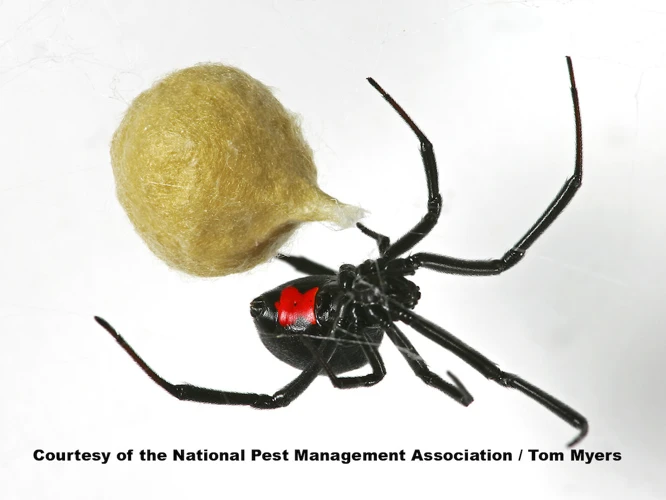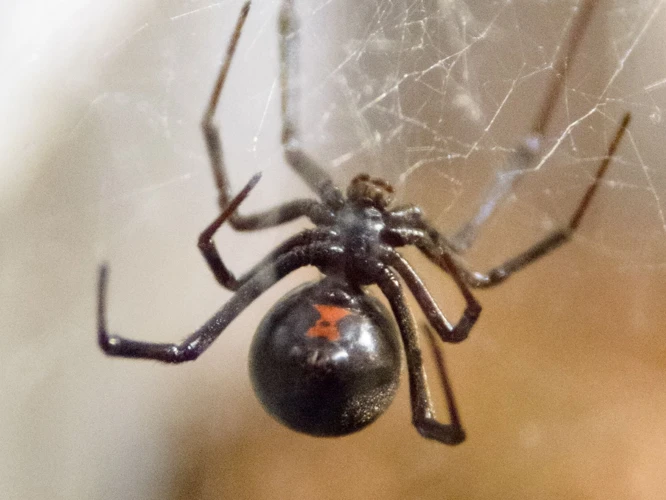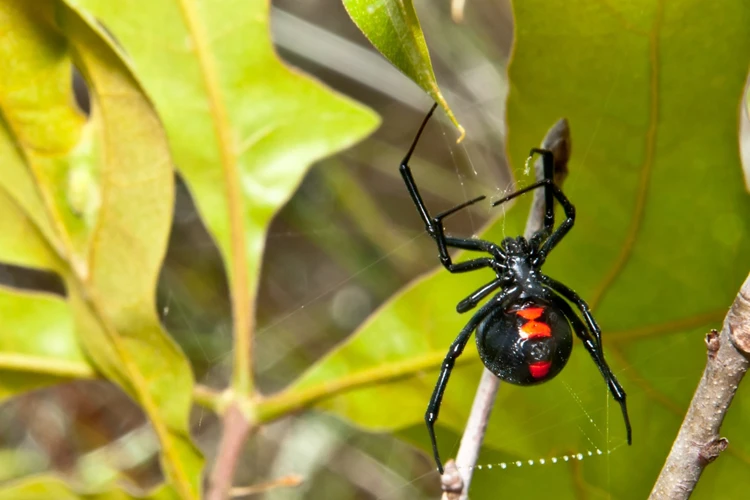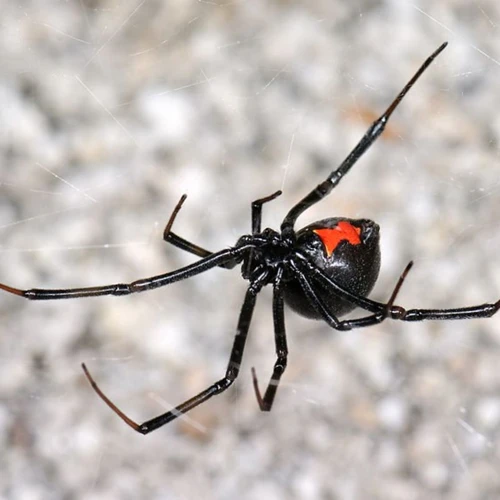Picture this: you stumble upon a cluster of ominous-looking black eggs neatly bundled together. Upon closer inspection, you realize that these are black widow spider eggs! These notorious arachnids are known to have an intimidating appearance and venomous bite. But have you ever wondered what it takes for their eggs to survive and eventually hatch? One of the key factors that highly affect black widow spider eggs is Temperature and Humidity. In this article, we’ll delve into the science behind these factors and its impact on the eggs, as well as some useful tips to create a suitable environment for these eggs to hatch safely. So, let’s dive in!
Factors Affecting Black Widow Spider Eggs

The successful development of black widow spider eggs is highly influenced by various environmental factors. Apart from the female’s reproductive behavior, the ideal conditions for egg-hatching spawn from several crucial elements. These environmental factors play a vital role in the maturation process of both male and female black widow spiderlings. Understanding these aspects can help us create an ideal environment for hatching robust and healthy black widow spider eggs. Let’s take a closer look at the environmental factors that greatly influence the hatching of black widow spider eggs.
Temperature
Temperature is a crucial factor in the development of black widow spider eggs. The eggs require a consistent and specific range of temperatures to reach maturity, as any deviations can adversely affect their growth and viability. So, what are the key things to keep in mind when it comes to the temperature requirements of black widow spider eggs?
1. Optimal Temperature Range
The ideal temperature range for the eggs of female black widow spiders is between 70 and 80°F (21 and 27°C). When the temperature is within this range, the eggs will attain maturity within 20 to 30 days.
2. Effects of High and Low Temperatures
High temperatures, over 90°F (32°C), can cause the eggs to dehydrate and even die. If the temperature falls below the optimal range, for example, between 40 and 50°F (4 and 10°C), the eggs may not hatch and could become stagnant. Males and females have different maturation timeframes with males maturing faster than females and since male widow spiders are not cannibalistic towards their babies, they need to reach sexual maturity quickly to be able to mate before they can be killed by the female. This is why temperature control is of utmost importance in the reproductive process of black widow spiders.
To understand more about the factors affecting black widow spider eggs, check out our article on environmental factors influencing black widow spider reproduction.
Humidity
Humidity plays a crucial role in the development of black widow spider eggs. Black widow spider eggs require an optimal humidity range to hatch successfully. If the humidity level is too high or too low, it can cause the eggs to become dehydrated or saturated with water, ultimately leading to their death.
Optimal Humidity Range: The optimal humidity range for black widow spider eggs is between 70% to 80%. If the humidity level goes below 70%, it may cause the eggs to become dry, leading to the shrinkage of the eggs. On the other hand, if the humidity level goes above 80%, it can cause the eggs to become saturated with water, which leads to a lack of oxygen, creating an unfavorable environment for the eggs to survive.
Effects of High and Low Humidity: High humidity levels can cause mold to grow, which can be fatal to spider eggs. While, low humidity levels can result in dehydration and hardening of the egg sac. The humidity also plays a critical role in the eggs’ silk production, which protects the eggs from outside threats.
To create an optimal environment for black widow spider eggs, it is essential to maintain a constant humidity level within the ideal range. If the humidity is too low, a humidifier can be used to increase it. Similarly, if the humidity is too high, a dehumidifier can be used to decrease it.
Humidity has a significant impact on black widow spider egg development. It is essential to control the environmental factors, such as humidity, to create an optimal environment for the eggs to develop successfully. Maintaining the ideal humidity range can help maximize egg hatching rates and ensure spiderling survival.
How Temperature Affects Black Widow Spider Eggs

Understanding the impact of environmental factors on black widow spiders’ eggs is crucial for their survival. Temperature, in particular, plays a significant role in determining the viability of these eggs. The right temperature range is essential to ensure their proper development and eventual hatching of spiderlings. In this section, we will explore the effects of temperature on black widow spider eggs, including the optimal temperature range and how high and low temperatures impact their development. To learn more about black widow spider reproduction and life cycle, check out /silk-black-widow-reproduction/.
Optimal Temperature Range
During the development of black widow spider eggs, maintaining the optimal temperature is crucial. The optimal temperature range for black widow spider eggs is between 26°C to 32°C. Any temperature below or above this range could impair the development of black widow spider eggs and may lead to unsuccessful hatching.
To give a better idea of the optimal temperature range, here’s a table showing the appropriate temperature range for black widow spider eggs:
| Temperature Range | Result |
|---|---|
| Less than 20°C | Slowed development and reduced hatching rate |
| 20°C to 25°C | Delayed development and reduced hatching rate |
| 26°C to 32°C (Optimal Range) | Ideal conditions for successful hatching |
| 33°C to 36°C | Accelerated development and reduced hatching rate |
| Greater than 36°C | Egg mortality and unsuccessful hatching |
It is important to maintain the optimal temperature range to ensure the eggs hatch into healthy black widow spiderlings. Any temperature fluctuation could negatively impact the growth and development of the spider eggs. A temperature outside the optimal range could also lead to developmental abnormalities, sex-ratio changes, and even death of the developing spiderlings.
In the next section, let’s take a closer look at the effects of high and low temperatures on black widow spider eggs.
Effects of High and Low Temperatures
Extreme temperatures can have a detrimental effect on black widow spider eggs. Temperatures that are too high or too low can cause the eggs to either fail to hatch or hatch with deformities. When exposed to temperatures above 90°F, the eggs can die, while temperatures below 70°F can slow down the development of the eggs, thereby increasing the incubation period.
High Temperatures: If the eggs are exposed to high temperatures, the embryos can become dehydrated and die, or the eggshells can harden before the spiderlings can hatch, making it difficult for them to escape. This is why it is crucial to avoid exposing the eggs to direct sunlight or other sources of heat.
Low Temperatures: On the other hand, exposure to low temperatures can also be harmful to the black widow spider eggs, as it can result in developmental delays or even death. Temperatures below 60°F can cause the embryos to become dormant and stop developing, while temperatures below 40°F can freeze and kill the eggs.
It’s important to note that the temperature preferences of the eggs may differ from those of the female black widow spiders, especially during mating. During mating, the male black widow spider may prefer warmer temperatures for optimal mating efficiency. However, this preference may not be ideal for the eggs’ development.
It’s crucial to maintain the optimal temperature range for black widow spider eggs to ensure their successful development and hatching. Temperature also plays a significant role in the maturation time of black widow spiderlings. For more information about black widow spider maturation, check out our article on spiderling maturation time.
How Humidity Affects Black Widow Spider Eggs

When it comes to black widow spider eggs, humidity is just as crucial as temperature. The moisture level in the air around the eggs can significantly impact their development and overall health. In fact, humidity levels that fall too far outside of the optimal range can even be fatal to the spiderlings inside. Let’s explore how humidity affects black widow spider eggs and what you can do to ensure the perfect environment for them to thrive. But first, let’s take a closer look at why spider eggs are so unique and require specific conditions for healthy development. If you’re interested in learning more about black widow spider eggs, you can click here to read our article on female black widow spider eggs and their life cycle.
Optimal Humidity Range
Maintaining the right humidity level is also essential for the healthy development of black widow spider eggs. The ideal humidity range for black widow spider eggs falls between 70% and 80%. This humidity range provides the optimal environment for the eggs to hatch successfully.
If the humidity level is too low, the eggs can dry out, causing them to die. On the other hand, if the humidity is too high, the eggs can become vulnerable to fungal growth and other bacterial infections. In such cases, the eggs may have a lower chance of survival.
It’s important to note that humidity levels can vary depending on the location, and on the time of year. For this reason, it’s important to monitor the humidity level closely, and make adjustments as necessary to ensure the optimal level is maintained.
To maintain the optimal humidity range, it’s recommended to use a humidifier or a mister. This will help to keep the eggs moist but not too wet. A good practice is to regularly measure the humidity level using a hygrometer, and adjust the humidifier or mister accordingly.
In addition to using a humidifier or mister, it’s also important to ensure proper ventilation. Good air circulation can prevent the buildup of excess moisture that could lead to fungal or bacterial growth. Regularly checking for mold or fungal growth is also advised.
Controlling the temperature and humidity in the environment is crucial for the successful hatching of black widow spider eggs. To learn more about the life cycle of black widow spiders and their behavior, check out this informative article on black widow spider life cycle.
Effects of High and Low Humidity
Optimal humidity plays a crucial role in the development of black widow spider eggs. When the humidity level is too high or too low, it can negatively affect the survival rates of black widow spider eggs. High humidity levels can promote the growth of bacteria and fungi, which can lead to the death of spider eggs. High humidity can cause the eggs to become moldy, making them more susceptible to bacterial and fungal infections. This is particularly important during the last stages of development when the eggs are hatching into spiderlings. If the humidity is too high, the spiderlings may not be able to break free from their eggs and suffocate. On the other hand, low humidity levels can dry out the eggs, causing them to become brittle and less elastic. As a result, the eggs can easily crack before they hatch, leading to a significant decrease in the number of spiderlings that successfully emerge.
To summarize, optimal humidity conditions are important for the proper development of black widow spider eggs. Maintaining a specific humidity range will prevent bacterial and fungal infections, reduce the risk of dehydration, and increase the overall survival rate of the spiderlings. For more information on the diet of black widow spiderlings, you can read our article on Black Widow Spiderlings’ Diet.
Creating the Perfect Environment for Black Widow Spider Eggs
Creating a safe and optimal environment is crucial for the survival of Black Widow Spider eggs. It is essential to understand the various factors that may affect their growth and develop strategies to control them. Temperature and humidity levels play an essential role in creating a perfect environment for these delicate eggs. If you want to learn more about the factors affecting Black Widow Spider eggs, you can read our previous section on Black Widow Spider Eggs. In this section, we will discuss some tips to help you create the perfect environment for the growth of Black Widow Spider eggs while controlling the temperature and humidity levels.
Tips for Controlling Temperature and Humidity
Maintaining the right temperature and humidity is crucial for the survival of black widow spider eggs. Here are some tips for controlling temperature and humidity to ensure the best environment for black widow spider eggs to thrive:
| Tips for Controlling Temperature: |
|---|
| 1. Use a thermometer: It’s crucial to monitor the temperature of the enclosure to make sure it’s within the optimal range. |
| 2. Use a heat source: If the temperature is too low, use a heating pad or lamp to maintain the proper temperature range. |
| 3. Avoid direct sunlight: Direct sunlight can cause the temperature to fluctuate and become too high for the eggs to survive. |
| 4. Keep the enclosure away from cold drafts: Cold drafts can quickly drop the temperature, which can be fatal for the eggs. |
Now, let’s look at the tips for humidity:
| Tips for Controlling Humidity: |
|---|
| 1. Use a hygrometer: A hygrometer is a great tool to monitor humidity levels. |
| 2. Mist the enclosure: When the humidity levels drop, misting the enclosure can help bring them back up quickly. |
| 3. Use a substrate: A substrate, such as peat or coco fiber, can help retain moisture and maintain humidity levels. |
| 4. Avoid overcrowding: Overcrowding can cause the humidity levels to rise due to the increased moisture from breathing and waste. Make sure there’s plenty of space for the eggs to breathe. |
By following these tips for controlling temperature and humidity, you can help create the optimal environment for black widow spider eggs to develop and hatch successfully. Remember that failure to control temperature and humidity properly can result in low hatch rates, deformed spiders, and even death.
Conclusion
In conclusion, it’s clear that temperature and humidity play a crucial role in the development of Black Widow Spider eggs. It’s essential to maintain the optimal temperature range and humidity levels for the eggs to hatch successfully and develop into healthy spiderlings. As we’ve discussed, different temperature and humidity levels can impact the eggs positively or negatively, emphasizing the importance of proper care and attention to these variables.
Moreover, as we know, the sex of Black Widow Spiders is determined by temperature, which makes temperature control even more critical. Males develop at lower temperatures, while females require a higher temperature range. Controlling humidity is also vital, especially considering that excessive moisture can lead to fungal growth and the death of spider eggs, as well as other species’ eggs.
Controlling temperature and humidity levels can be achieved by using various methods, such as controlling the lights and fans in the enclosure and regulating the moisture levels by using a dehumidifier or increasing the substrate’s depth. It’s also crucial to monitor the environment regularly to ensure that the conditions remain optimal.
Overall, successful Black Widow Spider breeding requires close attention to the environmental factors that affect egg development. By understanding how temperature and humidity impact eggs, we can create the perfect environment that fosters healthy Black Widow Spider eggs. Remember, breeding Black Widow Spiders is not easy, and it’s essential to keep in mind all factors, including sex-dimorphism and cannibalistic behavior. Learn about these factors by clicking on the relevant links: sex-dimorphism, cannibalistic behavior in Black Widow Spider babies, and male Black Widow Spider mating.
Frequently Asked Questions
What is the optimal temperature range for black widow spider eggs?
The optimal temperature range for black widow spider eggs is between 70 and 80 degrees Fahrenheit.
What is the optimal humidity range for black widow spider eggs?
The optimal humidity range for black widow spider eggs is between 70 and 80 percent.
What happens if the temperature is too high for black widow spider eggs?
If the temperature is too high for black widow spider eggs, they may hatch prematurely or not at all.
What happens if the temperature is too low for black widow spider eggs?
If the temperature is too low for black widow spider eggs, they may take longer to hatch or not hatch at all.
What happens if the humidity is too high for black widow spider eggs?
If the humidity is too high for black widow spider eggs, they may become overhydrated and not develop properly.
What happens if the humidity is too low for black widow spider eggs?
If the humidity is too low for black widow spider eggs, they may become dehydrated and not develop properly.
What are some ways to control temperature for black widow spider eggs?
Ways to control temperature for black widow spider eggs include placing them in an incubator or a warm room with a consistent temperature.
What are some ways to control humidity for black widow spider eggs?
Ways to control humidity for black widow spider eggs include adding water to the incubation container or using a humidifier or dehumidifier.
How long does it take black widow spider eggs to hatch?
Black widow spider eggs typically take between 20 and 30 days to hatch.
How many eggs do black widow spiders lay at a time?
Black widow spiders can lay up to 900 eggs at a time.






